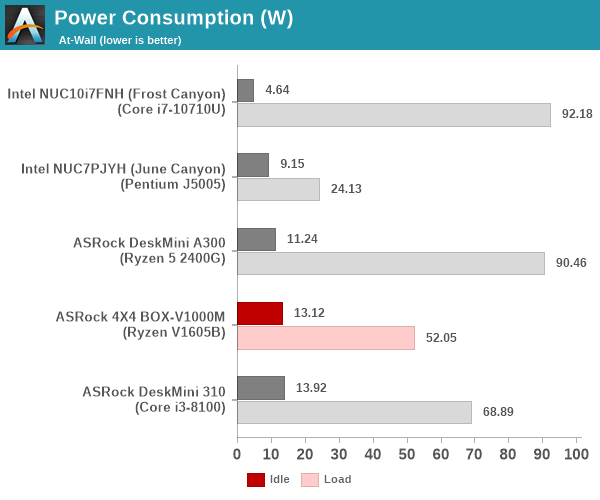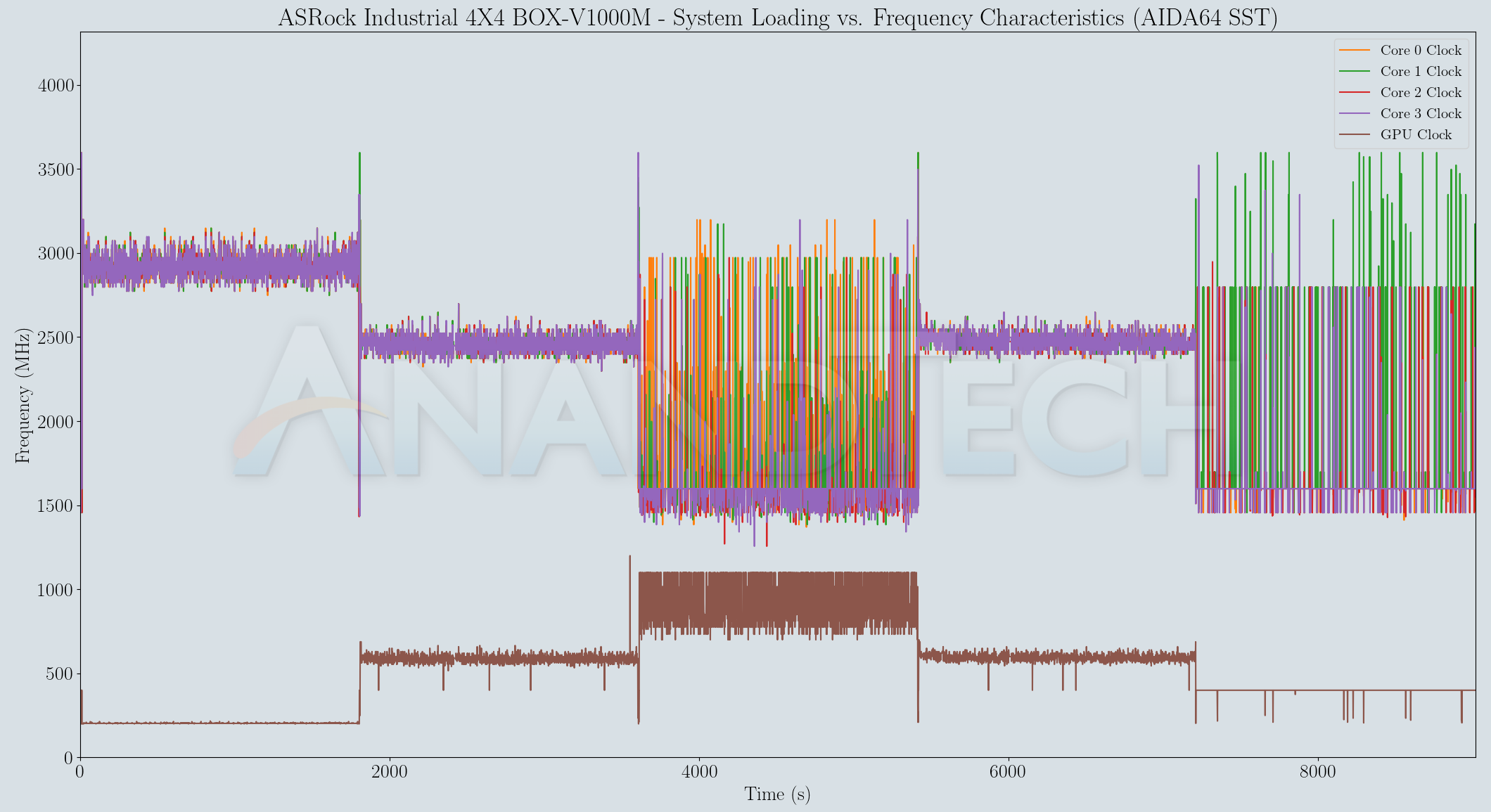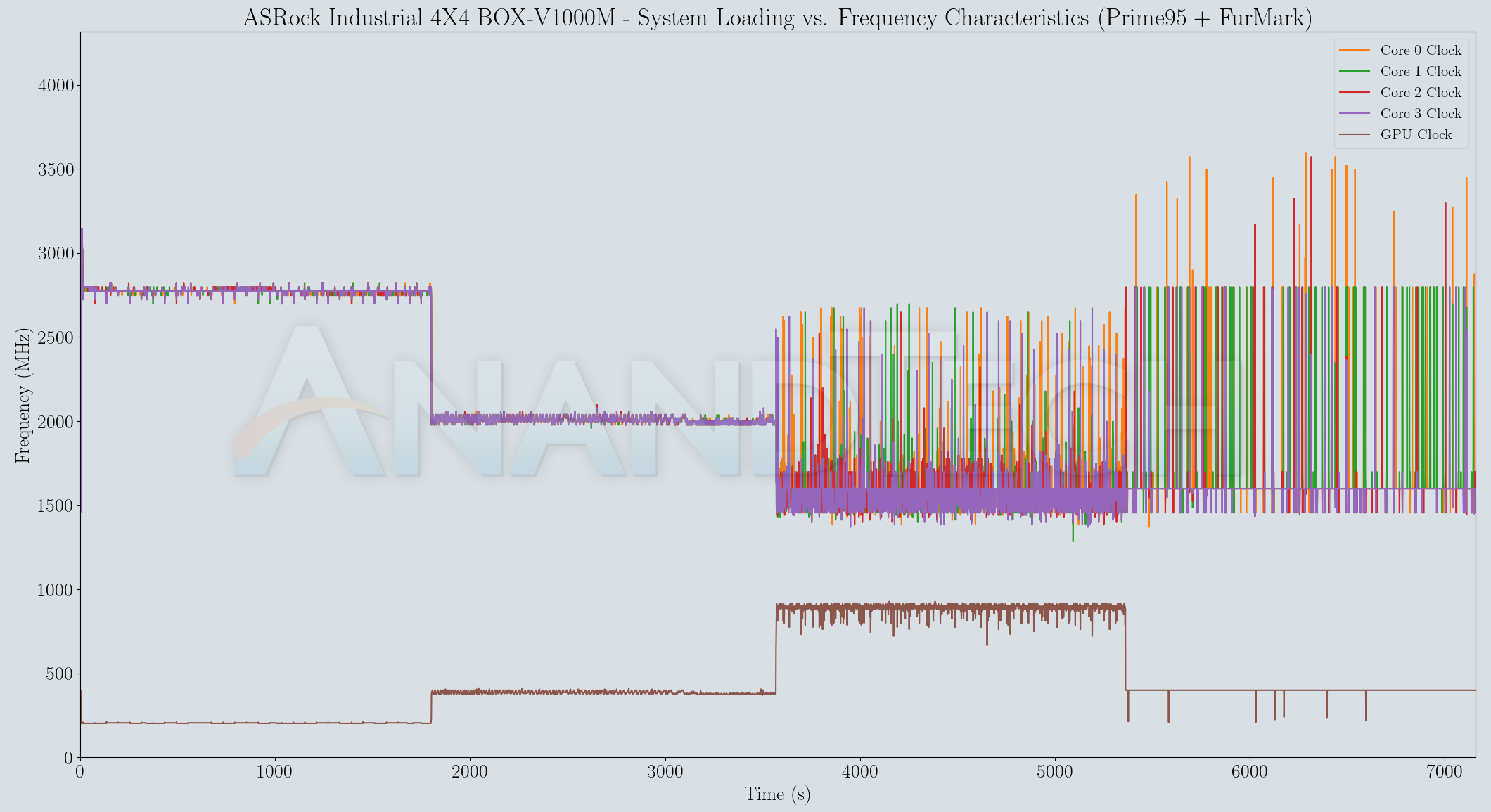ASRock Industrial 4X4 BOX-V1000M Ryzen Mini-PC Review: Finding Zen In The Small Things
by Ganesh T S on September 28, 2020 8:00 AM EST- Posted in
- Systems
- AMD
- NUC
- UCFF
- Ryzen
- Ryzen Embedded
- ASRock Industrial
Power Consumption and Thermal Performance
The power consumption at the wall was measured with a 4K display being driven through the HDMI port. In the graph below, we compare the idle and load power of the ASRock Industrial 4X4 BOX-V1000M with other low power PCs evaluated before. For load power consumption, we ran the AIDA64 System Stability Test with various stress components, and noted the maximum sustained power consumption at the wall.

The load power consumption of the 4X4 BOX-V1000M is reasonable given that no external peripherals were connected to the system, However, the idling power is a big cause for concern. In fact, it falls in the same league as the idling power for systems equipped with 65W TDP CPUs.
Our thermal stress routine starts with the system at idle, followed by four stages of different system loading profiles using the AIDA64 System Stability Test (each of 30 minutes duration). In the first stage, we stress the CPU, caches and RAM. In the second stage, we add the GPU to the above list. In the third stage, we stress the GPU standalone. In the final stage, we stress all the system components (including the disks). Beyond this, we leave the unit idle in order to determine how quickly the various temperatures in the system can come back to normal idling range. The various clocks, temperatures and power consumption numbers for the system during the above routine are presented in the graphs below.
| ASRock 4X4 BOX-V1000M System Loading with the AIDA64 System Stability Test | |||

There are no surprises in store - the cores stayed above the rated 2 GHz whenever the CPU was supposed to be actively working.The temperatures didn't go beyond 70C - the noisy fan curves (which has since been fixed by ASRock Industrial in the move from BIOS 1.1 to 1.40) definitely help in this aspect. The power numbers are a bit interesting - While the SoC starts off with a 25W spike, it settles down to around 22W quite quickly for the duration of the stress test. The at-wall consumption is steady around 50W during the process.
| ASRock 4X4 BOX-V1000M System Loading with Prime95 and Furmark | |||

Our custom stress test using Prime95 and FurMark also shows similar behavior profiles for the frequencies, temperatures and power consumption numbers.
According to the official specifications, the junction temperature of the V1605B is 105C. The thermal solution is very conservative and doesn't allow the SoC to reach anywhere near that number. Based on the frequencies of various SoC blocks, there was no thermal throttling at play either. Overall, ASRock Industrial has managed to create an effective, albeit noisy, thermal solution for the 4X4 BOX-V1000M.










37 Comments
View All Comments
nagi603 - Monday, September 28, 2020 - link
I wish those were intel NICs instead of Realtek, but you can't win all.webdoctors - Monday, September 28, 2020 - link
Love the title, haha.I like the TDP specs of this as I built a low power home nas machine for storing surveillance videos and home automation scripts. But the pricing on this is TERRIBLE. I built a tiny SFF machine for ~$130! It was like $60 for the mobo+CPU, $50 case+PS, $20 RAM etc.
What niche is this thing trying to fulfill?
eastcoast_pete - Monday, September 28, 2020 - link
Thanks for the review, although I would have really liked to see a review of that unit with the 4800u Renoir chip. The long-term support of this unit is, of course, interesting if one deploys them in actual "industrial" settings. However, I strongly assume that most readers here would use a small format PC like this as HTPC at home, and would gladly trade the superior performance of an 8 core Renoir for the "long-term support". So, any chance of seeing that review here?GreenReaper - Monday, September 28, 2020 - link
Why doesn't it use the 10GbE provided by the CPU, even at 1Gbps? Is it a question of power usage? Cost of transceivers? Reliability?eastcoast_pete - Monday, September 28, 2020 - link
10 GbE requires additional hardware (e.g. from Aquantia, or others); the situation is similar for many Intel-based systems. A number of current CPUs are capable of supporting 10 GbE, but all need the additional hardware. In contrast, 2.5 GbE can be implemented w/o adding much to the BOM, so more systems now ship with 2.5 GbE instead of just 1 GbE.GreenReaper - Monday, September 28, 2020 - link
Also, AMD is playing silly buggers with links to its specifications; the one in the article on the model number just leads to a menu page for me. This link has a V1000-series product brief:https://www.amd.com/en/media/42701/download
nicolaim - Monday, September 28, 2020 - link
No USB-C ports on something that's supposed to last up to ten years?PyroHoltz - Monday, September 28, 2020 - link
Good point. Maybe asrock knows something that we don't and usb-c is going to be replaced in the next 5?Lord of the Bored - Wednesday, September 30, 2020 - link
I doubt the target market is going to be plugging any USB-C... whatevers. I think the only things that actually ship with a USB-C connectors are laptop "docks" and USB-grownup-connector adapters.There's literally no benefit to USB-C in this segment.
PeterEvans - Monday, September 28, 2020 - link
Well I guess this is one way to get rid of the three year old laptop parts. Just put them together into a shoebox and call it "innovative". I am surprised it doesn't come with Windows XP.